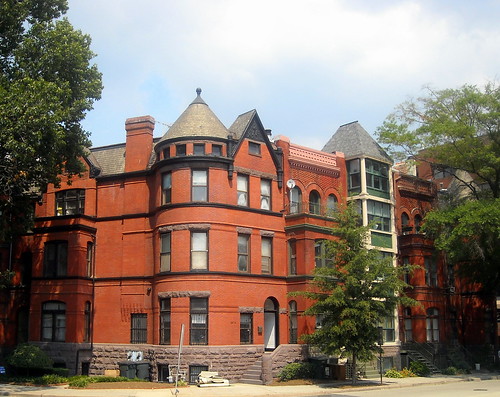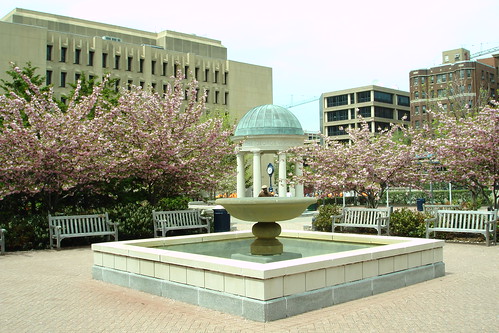
‘Schneider Triangle’
courtesy of ‘NCinDC’
Welcome to another installation of Where We Live. This time we’re focusing on the area between Dupont and Georgetown. Some call it Foggy Bottom, others call it GW, but the neighborhood most recently has been calling itself West End. Read on to hear why this area is among the city’s oldest, but also one of the most rapidly changing, neighborhoods.
History: The area is known as West End because it literally was the west end of Pierre L’Enfant’s original plan for Washington. It was also known as Foggy Bottom because of the marshy, humid conditions and the concentration of smoke-emitting businesses in the area along the waterfront (so really, it’s more like Smoggy Bottom). The rowhouses in the neighborhood housed these industrial workers, so the area was home to many Irish and German immigrants back in the 1850s, along with their breweries.
Then the area started changing rapidly. Columbian College (what we now know as George Washington University) was established near Meridian Hill in 1821, moved to the Foggy Bottom area in 1912, and expanded significantly in the 1920s and 1930s. The decline of river-oriented industries led to the closing of many waterfront employers, and the area lost a lot of ethnic diversity as industrial workers left the neighborhood. By the mid-twentieth century, rowhouses were being torn down in favor of high-density apartment buildings, and much of the character of the neighborhood was lost. We can thank the Foggy Bottom Restoration Association and the DC Restoration Office for preserving the rowhouses that still exist in the area today. (If you’re interested in more history of the neighborhood, check out this PDF brochure put out by the DC Office of Planning.)
Neighborhood Character: West End is now home to a thriving residential community, a number of local businesses, several corporations and institutions, and one very large university. There have been many conflicts throughout the years between the longtime residents that enjoy the quiet, residential nature of the area, and the George Washington University, which has grown substantially (it’s now 43 acres!) in size, enrollment, and prestige. In addition to GW, the World Bank, IMF, State Department, and Kaiser Permanente have large offices in the area.

‘National Cherry Blossom Festival 2009 – 76’
courtesy of ‘giantminispacegoat’
Despite the large institutional presence, there’s a definite neighborhood feel on the streets lined with rowhouses and apartment buildings. Residents enjoy easy walking access to both Dupont Circle and Georgetown, to the variety of neighborhood restaurants and bars, and to the resources right next door at GW (who wouldn’t want a well-respected hospital and a plethora of performances and lectures and events in their neighborhood?).
Square 54, aka that construction that you see as soon as you step out of the Foggy Bottom-GWU Metro station since the old hospital has been demolished, has been a major source of contention in the town/gown feud. In fact, the argument has recently gone to the courts, as the Foggy Bottom Association has attempted to overturn the ruling of the Zoning Commission that approved the GW Campus Plan and the planned unit development at Square 54. Last month, the court heard arguments from both sides, and a decision is expected within the next few months.
Transportation: The Foggy Bottom-GWU Metro station opened in 1977 and is the last station on the blue and orange lines in DC before you go under the Potomac to Rosslyn. The station has had some recent escalator issues (you can even join a Facebook group to complain!), and since it only has one entrance to serve many very different sets of users (university students, neighborhood residents, and State Department/World Bank/hospital/office employees, Kennedy Center patrons, and suburbanites trying to take Metro to Georgetown) there’s no real down time to make repairs without inconveniencing large groups of people. Luckily, there’s good bus service in the area: the DC Circulator connects the area with Union Station and Georgetown, and numerous Metrobus routes connect the neighborhood to virtually every corner of DC.
Points of Interest: If you find yourself with some time to kill in Foggy Bottom, here are some things to check out:
- There’s a free shuttle to the Kennedy Center from the Metro station, so you have no excuse to not head over for a free Millenium Stage performance, or one of the other 2,000 events put on every year.
- The only Trader Joe’s grocery store in the city opened at 25th and L in 2006, so stop by and enjoy “bourgeois products at proletarian prices.” But be forewarned, if you’re there on a weekend afternoon, there will be a ridiculously long checkout line greeting you when you walk in the door.
- Take advantage of the proximity to George Washington University. On their Neighborhood website, there’s a list of events open to the public (though it hasn’t been updated since March), information on an annual October block party for the community, and links to university attractions like athletics and performing arts. You’ve gotta hand it to GW, they’re at least trying to be neighborly.
- Definitely stop by Swing’s Coffee, a DC institution for nearly 100 years. It’s moved around the city a couple times since 1916, but it’s been at 17th and G for over a decade and has a very strong neighborhood following.
- Need a drink? Tonic has a good happy hour and a trivia night on Mondays, McFadden’s is student-dominated but has some fun events and cheap drinks, and Skye Lounge caters to a different crowd with martinis and mojitos.
- Stop by the Foggy Bottom Farmer’s Market from 2:30 to 7 PM on Wednesdays at 24th and I Streets for fresh fruits and vegetables, flowers, cheeses, and breads.
Neighborhood Blogs: Despite the strong opinions on all sides of the town/gown power struggle, there are only two real neighborhood-focused blogs out there, one from each side: The GW Hachet District Blog and the Foggy Bottom Association blog. Additionally, the GW Hachet Newsroom Blog covers University news and events.
Why We Love It: The West End area is rich in history and has been able to preserve the residential feel of the neighborhood despite a large university next door and a number of corporate headquarters and offices down the street. There’s always something happening at GW or the Kennedy Center, the area has great access to downtown, and there are beautiful historic rowhouses throughout the neighborhood. Now, if they could only fix the escalators at the Metro station…
Some corrections: GW was founded as Columbian College in 1821, not 1921! The original campus was on College Hill, adjacent to what is now Meridian Hill Park. GW moved to Foggy Bottom in 1912.
Thanks for setting me straight, GWalum. I’ve updated the post with those corrections!